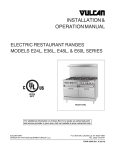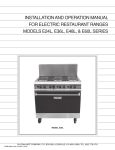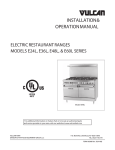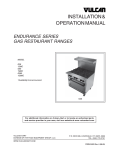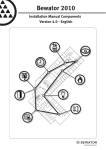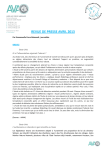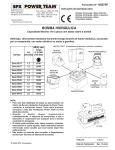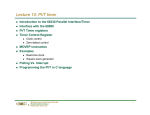Download Vulcan-Hart E60L Service manual
Transcript
SERVICE MANUAL FOR ELECTRIC RANGES MODELS E24L, E36L, E48L AND E60L SERIES ML NOS. 52361 THROUGH 52372 MODEL E36L SHOWN VULCAN-HART COMPANY, P.O. BOX 696, LOUISVILLE, KY 40201- 0696, TEL. (502) 778-2791 FORM 30900 SERVICE MANUAL FOR ELECTRIC RANGES MODELS E24L, E36L, E48L AND E60L SERIES IMPORTANT FOR YOUR SAFETY THIS MANUAL HAS BEEN PREPARED FOR PERSONNEL QUALIFIED TO SERVICE AND ADJUST THE EQUIPMENT COVERED BY THIS MANUAL. INFORMATION ON THE CONSTRUCTION AND INSTALLATION OF VENTILATING HOODS MAY BE OBTAINED FROM THE "STANDARD FOR THE INSTALLATION OF EQUIPMENT FOR THE REMOVAL OF SMOKE AND GREASE LADEN VAPORS FROM COMMERCIAL COOKING EQUIPMENT," NFPA NO. 96 (LATEST EDITION) AVAILABLE FROM THE NATIONAL FIRE PROTECTION ASSOCIATION, BATTERY MARCH PARK, QUINCY MA. 02269. FOR AND APPLIANCE EQUIPPED WITH A FLEXIBLE ELECTRIC CORD, A THREE PRONG GROUNDING PLUG IS SUPPLIED. THIS GROUNDING PLUG IS FOR YOUR PROTECTION AGAINST SHOCK HAZARD. DO NOT CUT OR REMOVE THE GROUNDING PRONG OF THIS PLUG. THE GROUNDING PLUG SHOULD BE USED WITH A PROPERLY GROUNDED THREE PRONG RECEPTACLE. IF THE APPLIANCE IS NOT EQUIPPED WITH A GROUNDING PLUG, AND ELECTRIC SUPPLY IS NEEDED, GROUND THE APPLIANCE USING THE GROUND LUG PROVIDED. FOR YOUR SAFETY DO NOT STORE OR USE GASOLINE OR OTHER FLAMMABLE VAPORS/LIQUIDS IN THE VICINITY OF THIS APPLIANCE. WARNING IMPROPER INSTALLATION, ADJUSTMENT, ALTERATION, MODIFICATION, SERVICE OR MAINTENANCE CAN CAUSE PROPERTY DAMAGE, INJURY OR DEATH. READ ALL INSTRUCTIONS THOROUGHLY BEFORE SERVICING THIS EQUIPMENT. 2 TABLE OF CONTENTS DESCRIPTION PAGE IMPORTANT CODE, SAFETY AND WARNING INFORMATION DATA PLATE, ELECTRICAL, AND APPLIANCE CLEARANCE INFORMATION APPLIANCE FEATURES SECTION I SERVICE CHECKS SECTION II SERVICE ADJUSTMENTS SECTION III REMOVAL AND REPLACEMENT OF SERVICEABLE PARTS SECTION IV WIRING DIAGRAMS 2 3 3 4-7 8-9 10 - 34 35 - 39 DATA PLATE LOCATION The appliance data plate stating model number, serial number, manufacturing date and electrical specifications is located behind the kick panel on the left side appliance front frame. ELECTRICAL SPECIFICATIONS Refer to Configuration/Electrical Specification Load Chart label located on the back of the lower kick panel. CLEARANCES All models except those equipped with the ESB Broiler require 0" clearance at both sides and rear to combustible construction. Models with the ESB Broiler require an 8" clearance at the sides and a 2" clearance at the rear to combustible construction. FEATURES 26" wide x 22" deep x 121⁄2" high oven with 1250 watt top oven heating elements and 3750 watts bottom heating elements. Top elements are controlled by infinite switch and the bottom elements are controlled by an adjustable thermostat. The range top may have cast iron french top plates or optional hot top, griddle or high speed elements as shown in model no. chart below. The chart below shows only the basic model nos. For additional configuration refer to the Configuration/Electrical Specification Charts in the back of this manual. E24L = 24" wide single oven range with (4) french plates or (2) high speed elements or (1) hot top in place of (2) french plates in the vertical position. E24FL = 24" wide single oven range with a 24" Griddle top. E36L = Single oven range with (6) french top plates or (2) high speed elements or (1) hot top section in place of (2) french plates in the vertical positions. E36FL = Single oven range with (2) french top plates and (1) 24" griddle top or (1) hot top section in place of the (2) french plates. E36XL = Single oven range with (1) 36" griddle top. E48L = 48" wide unit with (2) oven sections and (8) french plates or (2) high speed elements or (1) hot top in place of (2) french plates in the vertical position. E48FL = 48" wide unit with (2) ovens and a 24" griddle to the right and (4) french plates or (2) Hot tops to the left. E60L = Double oven range with (10) french top plates or (2) high speed elements or (1) hot top section in place of (2) french plates in the vertical positions. E60FL = Double oven range with (6) french top plates and (1) 24" griddle top or (3) hot top sections in place of the french plates. E60XL = Double oven range with (4) french top plates and (1) 36" griddle top or (2) french top plates, (1) hot section with (1) 36" griddle top. In all of the above the french plate sections may be replaced by high-speed elements. The above may also be equipped with an ESB Elevated Salamander Broiler. These units are indicated by the Suffix letter B in the unit model number. ESB Broilers cannot be mounted over any unit equipped with hot top sections. 3 SECTION I SERVICE CHECKS WARNING: WARNING: UNPLUG OVEN BEFORE SERVICING. CERTAIN PROCEDURES IN THIS SECTION REQUIRE ELECTRICAL TEST OR MEASUREMENTS WHILE THE POWER IS APPLIED. EXERCISE EXTREME CAUTION AT ALL TIMES. IF TEST POINTS ARE NOT EASILY ACCESSIBLE DISCONNECT POWER, ATTACH TEST EQUIPMENT AND REAPPLY POWER TO TEST. THERMOSTAT CALIBRATION CHECK If the product recipe catic for 350 degrees for 30 minutes and at the end of the cooking time with thermostat set at 350 degrees your product is consistantly under or over cooked the oven thermostat may be out of calibration and should be checked and adjusted if required. If calibration is a suspected problem perform steps 1-6 below to determine the center average heating temperature the oven and refer to Section II of the manual if thermostat calibration is required. 1. Turn oven off, allow it to cool then open the oven door. 2. Place oven rack in center oven position. 3. Place a calibrated potentiometer thermocouple in the oven cavity centered on the oven rack. 4. Turn oven on and set oven temperature to 350 degrees F. 5. Allow the oven to cycle 3 complete times. 6. After the third cycling period, record cycle at highest point, record cycle at lowest point. Example: High point 360 degrees F. (Burner cycle off temperature) Low point 340 degrees F. (Burner cycle on temperature) Differential: If the differential exceeds 25 degrees F. then thermostat should be replaced. To calculate this example or any other high/low point center oven average follow the method below. Add the highest and lowest cycle values together then divide this value by 2. Example: 360 + 340 = 700 then 700 divided by 2 = 350. The calibration set point will be 350 degrees F. INFINITE SWITCH CHECK 1. With power on using a volt meter check for 120 Volts AC input across H1 and H2 terminals. 2. H2 has 120V AC Output, but it is not a constant output. The output will cycle on and off as long as the input to the switch is present. The timing of this output is determined by the switch setting. By timing the switch cycles at various settings you can determine if the switch is properly working. See the chart below. DIAL SETTING PERCENT ON TIME SECONDS ON SECONDS OFF Hi 100 ALL 0 Med. 48 15 15 Low 37 8 14 Med. Low 28 7 24 Very Low 7 3 33 NOTE: The P terminal is a neutral leg of the switch. When the control is turned from the off position to any other position P is making contact with L1. L1 is a neutral connection. L2 is a 120V AC input. H1 is used as a neutral point for testing of load control output. 4 ON-OFF SWITCH CHECK 1. Follow steps 1-3 under the 4-Heat switch check except, using an ohmmeter check for continuity in the off position as follows: P1 to 2 P2 to 3 P2 to 4 If the above is not proven replace the switch. 5 TROUBLESHOOTING PROBLEM CORRECTIVE ACTION Range is completely dead. Check to insure the main store power supply is on. Check to insure the appliance is wired to power supply. Check to insure that the appliance power switch is on and that switch is not bad. Oven section elements are dead but top surface elements are working. Check for proper voltage and connections between oven section circuit breakers and thermostat. Check to see if the oven breaker has tripped or is defective. Check for proper connections to the terminal block and main power supply. Top element of the oven section is dead. Check voltage of top oven element infinite switch. Check for voltage at the top oven element terminals. Check for defective infinite switch. Check all wiring associated with the element for good connections. Check oven thermostat and wire connections. Bottom element of oven section is dead. Check oven thermostat and wire connections. Check for voltage at the bottom oven element terminals. Check all wiring associated with the element for good connections. French plate or high speed element dead. Check for voltage between H1 and H2 terminals of the french plate infinite switch in the HI position. Check for defective element or wire connections. Check voltage between the L1 and L2 terminals of the infinite switch. If you have voltage the switch is bad. If no voltage, check the supply connections to the L1 and L2 terminals. Griddle element dead. Check for defective griddle thermostat. Check for voltage at the griddle element terminals. Check for bad wire connections of the elements and thermostat. Hot top section is dead. Check for defective 4-heat and on-off switches. Check for element voltage. Check for bad wire connections of the element, 4heat and on-off switches. Circuit breaker trips as soon as appliance is turned on. Check for short circuit to ground and between lines. With power off check for resistance between each line and chassis ground. With power off check continuity with ohmmeter between line phases. 6 TROUBLESHOOTING PROBLEM The circuit breaker trips after the range as been operating for a few minutes. CORRECTIVE ACTION The slow trip of a circuit breaker is an indication of overload in a particular circuit. The cause of this overload could be: Voltage problem, check element voltage against store and rating plate voltages. Element may also be defective; Measure the amps of the suspicious element and compare this with the expected value. The value is calculated by dividing the watt rating of the element (see wiring diagram) over the supply voltage. Example: For a 208V french plate the reading would be: 2000 watt = 9.6 amps 208 volt Check for defective breaker: Measure the amps of the suspicious breaker with all elements turned fully on. If reading is not exceeding 50 amps and the breaker trips, replace the breaker. 7 SECTION II SERVICE ADJUSTMENTS WARNING: WARNING: UNPLUG OVEN BEFORE SERVICING. CERTAIN PROCEDURES IN THIS SECTION REQUIRE ELECTRICAL TEST OR MEASUREMENTS WHILE POWER IS APPLIED TO THE OVEN. EXERCISE EXTREME CAUTION AT ALL TIMES. IF TEST POINTS ARE NOT EASILY ACCESSIBLE DISCONNECT POWER, ATTACH TEST EQUIPMENT AND REAPPLY POWER TO TEST. OVEN DOOR ADJUSTMENT 1. Lower the kick panel. 2. Pull door spring slightly out with large screwdriver. (Fig. 1) Fig. 1 3. Using a 5⁄16" socket loosen (2) hex nuts holding the turn buckle in place. Turn the buckle "J" bolts (left and right side) slightly retighten the nuts and test door for proper closure. Generally the door is properly adjusted when it closes on its own as you rise it to the half closed position. (Fig. 2) Fig. 2 8 THERMOSTAT ADJUSTMENT 1. Perform calibration check as stated under Section I. 2. Remove the thermostat knob. (Fig 3) Fig. 3 3. Insert a flat blade screwdriver into the thermostat dial stem until it reaches the calibration screw. 4. Note the calibrated center oven average as determined under Section 1 Calibration Check. Use that number as the calibration set point. 5. Turn the adjustment screw to the right to increase the temperature and to the left to decrease the temperature. A 1⁄4" turn in either direction will change the temperature by 35 degrees. 6. Perform the calibration check again and repeat the above procedure to insure that the correct center oven average temperature has been obtained. 7. Reinstall the thermostat knob, be sure to align the knob correctly on the thermostat stem. 9 SECTION III REMOVAL AND REPLACEMENT OF SERVICEABLE PARTS WARNING: WARNING: UNPLUG OVEN BEFORE SERVICING. CERTAIN PROCEDURES IN THIS SECTION REQUIRE ELECTRICAL TEST OR MEASUREMENTS WHILE POWER IS APPLIED TO THE OVEN. EXERCISE EXTREME CAUTION AT ALL TIMES. IF TEST POINTS ARE NOT EASILY ACCESSIBLE DISCONNECT POWER, ATTACH TEST EQUIPMENT AND REAPPLY POWER TO TEST. DROPPING OF CONTROL MANIFOLD COVER 1. Pull crumb tray out. (Fig. 4) Fig. 4 2. Remove (2) 10-24 sheet metal screws (Fig. 5) Fig. 5 10 3. Fold control manifold cover down and rest it on the crumb tray. REMOVAL OF INFINITE SWITCH 1. Follow steps 1- 2 for dropping the control manifold cover. 2. Pull switch knob off of the control manifold cover. (Fig. 6) Fig. 6 4. Remove the washer nut from the infinite switch stem. (Fig. 7) Fig. 7 11 5. Lay the manifold cover down so that it rest on the crumb tray. (Fig. 8) Fig. 8 6. Note and remove the infinite switch wire connections. (Fig. 9) Fig. 9 7. Remove the switch from the appliance. 8. Reinstall new switch by reversing steps 1 through 6. 12 REMOVAL OF ON-OFF AND 4-HEAT SWITCHS (EGO Hot top only) 1. Pull crumb tray out about 6". 2. Remove the screws at the top left and right corners of the control panel. 3. Lower panel on to the crumb tray. 4. Label and disconnect wires to the switch. 5. Lift panel up and pull off the switch knob. 6. Remove (2) switch mounting screws. (Fig. 10) Fig. 10 7. Pull switch from the control panel. 8. Install new switch by reversing steps 1-7. 13 REMOVAL OF INDICATOR LIGHTS 1. Follow steps 1-2 for dropping the control manifold cover. 2. Lay the manifold cover down so that it is resting on the crumb tray. 3. Locate the light from the rear of the cover. (Fig. 11) Fig. 11 4. Note and remove the light wiring. (Fig. 12) Fig. 12 14 5. Squeeze the light mounting tabs in towards the light body casing and push the light through the manifold cover opening and out of the appliance. (Fig. 13) Fig. 13 6. Install new light by reversing steps 1 through 5. REMOVAL OF THERMOSTAT 1. Follow steps 1-2 for removal of control manifold cover. 2. Pull thermostat knob from the front of the control manifold cover. 3. Remove (2) screws from the front of the manifold cover. (Fig. 14) Fig. 14 15 4. Note and remove all wiring associated with thermostat. (Fig. 15) 5. Lift up the left top aeration plate assembly to expose the top burner box area. (Fig. 16) Fig. 15 Fig. 16 6. Open the oven door. 7. Remove the oven rack(s). 8. Lift the thermo bulb out of the bulb clip holders located inside the oven on the top oven back. (Fig.17) BULB CLIPS Fig. 17 16 9. Locate the bulb access hole in the oven cavity, top left hand corner, and carefully feed the bulb and thermopile lead through the opening. (Fig. 18) Fig. 18 10. From the burner box top left side, pull the thermopile lead and bulb from the oven. (Fig. 19) Fig. 19 17 11. Reinstall the new thermostat by reversing steps 1-10. REMOVAL OF FRENCH PLATE 1. Remove (2) bolts at top of control panel. 2. Lower control panel. 3. Using a 5⁄16" socket remove (1) hex head retaining screw holding the range top mounting bracket to the front burner box cover. (Fig. 20) Fig. 20 4. Remove the backsplash. (See fig. 27) 5. Lift up on the aeration plate, push plate towards the rear of the unit, then lift plate assembly out and flip it over. (Fig. 21) 6. Using a 5⁄16" socket, remove (2) bolts holding the mounting bracket to the french plate assemblies. (Fig. 21) Fig. 21 18 7. Note and remove (2) wires from the plate receptacle. (Fig. 22) Fig. 22 8. Remove the nut and locking bracket from the plate bottom. (Fig.23) Fig. 23 19 9. Lift plate out of the aeration plate top. 10. Install new french plate by reversing steps 1-9. REMOVAL OF HIGH SPEED ELEMENTS 1. Remove the back riser. 2. Flip over aeration plate to expose the element terminal ends and wiring. 3. Note and disconnect all element connector and grounding wire(s). (Fig. 24) WIRE CONNECTION POINTS WIRE CONNECTION POINTS Fig. 24 4. Snap the element out of the ring/bowel assembly. (Fig 25) Fig. 25 20 5. Install new element by reversing steps 1-4. When installing new element, be sure to align the element mounting tab with the mounting slot provided in the element ring before snapping the element firmly in place. (Fig. 26) Fig. 26 HOT TOP PLATE/ELEMENT ASSEMBLY REMOVAL 1. Remove the backsplasher. (Fig. 27) Fig. 27 21 2. Using a 5⁄16" socket, remove (2) hex head screws from the upper corners of the control panel. 3. Using a 5⁄16" socket, remove the hex head screws holding the plate mounting bracket to the front burner box cover. (Fig. 28) SCREW LOCATION Fig. 28 4. Flip the hot top plate assembly over. (Fig. 29) 5. Remove (2) 12mm nuts holding the mounting bracket to the plate assembly. (Fig. 29) Fig. 29 22 6. Note and disconnect the wiring for the hot top section. (Fig. 30) Fig. 30 7. Reinstall hot plate by reversing steps 1 through 6. 23 REMOVAL OF GRIDDLE TOP 1. Remove riser or back guard. 2. Using a 5⁄16" socket, remove (1) 10-24 screw from the front burner box securing the top mounting bracket to the appliance. (Fig. 31) SCREW LOCATION Fig. 31 3. Tilt griddle up towards the back of the appliance. 4. Note and disconnect the element wiring. (Fig. 32) WIRE CONNECTION POINTS Fig. 32 5. Install new griddle assembly by reversing steps 1-3. 24 REPLACEMENT OF GRIDDLE TOP ELEMENTS 1. Follow steps 1-3 under removal of griddle top. 2. Using a 7⁄16" socket, remove griddle base cover by disengaging (9) hex head bolts and lifting the cover off of the griddle assembly. (Fig. 33) 24" WIDE GRIDDLE ASSEMBLY Fig. 33 3. To lift the element from the griddle assembly, use a 7⁄16" and a 5⁄16" socket to disengage the element holding clamps from the griddle plate. (Fig. 34) 5/16" HEX HEAD NUT 7/16" HEX HEAD NUT Fig. 34 4. To install new element reverse steps 1-3. 25 REMOVAL OF OVEN BOTTOM 1. Open oven door. 2. Remove oven rack(s). 3. Lift oven bottom tray up and out of the appliance. (Fig. 35) Fig. 35 REMOVAL OF THE BOTTOM OVEN ELEMENTS 1. Follow steps for removal of the oven bottom. 2. With a 5⁄16" socket, loosen (12) element mounting clamps. (Fig. 36) LOOSEN CLAMP BOLT Fig. 36 26 3. Lower the kick panel. (Fig. 37) Fig. 37 4. With a 5⁄16" socket, remove (2) screws holding the element terminal cover. Flip cover down. (Fig. 38) Fig. 38 27 5. Note and disengage element terminal wiring. (Fig. 39) Fig. 39 6. From inside the oven cavity, slip the bottom element out of the mounting clamps. Pull the element through the oven burner box and cavity area, out of the appliance. (Fig. 40) ELEMENT CLAMP ELEMENT Fig. 40 7. Install new element by reversing steps 1-6. (When installing new element Do Not force element into place. Work the mounting clamps around until the element properly seats without force.) 28 REPLACEMENT OF TOP OVEN ELEMENT 1. Flip over the left hand top section or aeration plate and let it lay over one of the center top sections. (See Fig. 21) 2. From the left hand side of the top burner box area, remove the rubber covers on the element terminal ends. (Fig. 41) Fig. 41 3. Note and disconnect the terminal wiring. (Fig. 42) Fig. 42 29 4. Open oven door and remove the oven rack(s). (Fig.43) CAVITY AREA WITHOUT OVEN RACKS Fig. 43 5. Loosen (19) top element clamps using a 5⁄16" socket. (Fig. 44) LOOSEN SCREWS Fig. 44 30 6. Slip the element out of the clamps (clamps may require removal if turning them will not free the element completely). 7. Pull the element through the top burner box outwards into the oven cavity and remove it from the appliance. 8. Install new element by reversing steps 1-7. (When installing a new element Do Not force or jam the element into the holding clamps. Do Not force or jam the terminal ends through the oven cavity top mounting holes. Force may damage the elements. The holding clamps can be removed if the element will not slip easily into the clamp mounting slot.) REPLACEMENT OF OVEN DOOR 1. Lower the kick panel. 2. Using a flat head screwdriver, pry up on both the left and right hand bell cranks (one at a time) until they release from the bell crank hooks. Remove the hooks from the door arm. (Fig. 45) Fig. 45 3. Open the oven door and remove the oven rack(s) and oven bottom. 31 4. From inside the oven cavity, located behind the front frame where the door is mounted, using a 7⁄16" socket, remove (2) nuts holding the door assembly to the trunnion block (1) on the left door side and (1) on the right. (Fig. 46) NUT DOOR ARM FRONT FRAME Fig. 46 5. Slip the trunnion block through the mounting slot and remove the door assembly from the appliance. 6. Install new door assembly by reversing steps 1-5. After door replacement the door may require adjustment. If adjustment is necessary refer to Section II of this manual under door adjustment. REPLACEMENT OF TERMINAL BLOCK 1. Lower the kick panel. 2. Using a large flat head screwdriver, note and remove wiring from the terminal block connection points. (Fig. 47) Fig. 47 32 3. Using a 5⁄16" socket wrench, remove (3) sheet metal screws securing the terminal block to the control housing. Remove the block from the appliance. (Fig. 48) Fig. 48 4. Install new terminal block by reversing steps 1-3. REPLACEMENT OF BREAKER 1. Lower kick panel. 2. With a 5⁄16" socket, remove (2) hex head retaining screws holding the breaker cover over the breakers. To remove the cover tilt the bottom right end over the exposed access panel screws. Slide the breaker panel to the right until it touches the sidewall. Tilt the bottom left end out and over the left door spring and pull the breaker cover panel out. 3. Note and remove breaker wiring using a large flat head screwdriver. (Fig. 49) Fig. 49 33 4. With a 5⁄16 socket wrench, remove the sheet metal screws securing the breaker to the control housing and slip the breaker out of the appliance. Install new breaker by reversing steps 1-3. (Fig. 50) Fig. 50 34 SECTION IV WIRING DIAGRAMS THE NEXT FOUR PAGES ARE DEDICATED TO WIRING INFORMATION OF THE E24L, E36L AND E60L ELECTRIC RANGES FOR ADDITIONAL WIRING INFORMATION CONTACT THE VULCAN-HART CO. SERVICE DEPARTMENT AT THE PHONE NUMBER LISTED ON THE BOTTOM FRONT COVER OF THIS MANUAL. 35 E24L 36 E36L 37 E48L 38 E60L 39







































